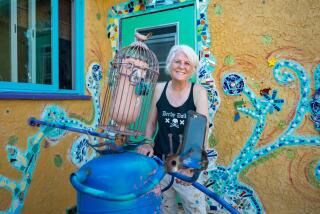‘Melon’ Removal Sows Seeds of Sculptor’s Discontent : Art: Hal Meltzer is none too happy that the city removed his work from its 5-year-old former sculpture garden without his permission.
BEVERLY HILLS — Public art isn’t what it used to be in Beverly Hills, where the weeds of neighborly discontent started popping up in the municipal sculpture garden soon after it was planted five years ago.
The most rank growth was George Herms’ “Moon Dial,” a thicket of rusty buoys, chains and window frames that outraged nearby residents and was uprooted shortly--very shortly--after the end of its 18-month loan period in 1989.
The remaining, less controversial artistic flora--Woods Davy’s “Jatay,” Jay Willis’ “Billboard”--stayed in place along heavily traveled Santa Monica Boulevard until earlier this year. Then they too were plucked up and returned to their makers.
All but one.
Hal Meltzer’s “Melon,” a fading representation of an outsized slice of citrullus vulgaris, was still peeking out from its place in a stand of bamboo as recently as late last month, when an official letter dated May 20 went out to the artist’s summer residence in Hope, Ida.
It advised Meltzer in no uncertain terms that since two previous requests to take his “Melon” away had gone unanswered, the work would be transported to a city storage facility on May 26.
And so it was. Meltzer, who recently returned from a winter’s hibernation in Europe, was not very happy about it.
“It’s been really bizarre,” he said Wednesday in a call from Hope, a hamlet near the Canadian border. “I’ve forbidden them to touch it.”
It was a little too late for that by then, of course. But Nancy Nebenzahl, chairwoman of the city’s Fine Arts Commission, said Thursday that “Melon” is in a safe place.
“It’s in storage waiting for him to pick it up or whatever,” she said. “If we don’t hear anything, then we’ll find out from the city attorney what we should legally do and we’ll just proceed on that basis.”
As for the sculpture garden, she said, its time has come and gone, except for “Clouds,” a piece by Malcolm Susman, which falls into a different category because it was a gift to the city.
Instead of arranging for artists to loan their works for exhibition along Santa Monica Boulevard, she said, the Fine Arts Commission is concentrating on adornments for the city’s new Civic Center.
“The idea is really a thing of the past,” she said. “The other was OK for then, but now that we have our beautiful Civic Center, we want to enhance it.”
Already, “Home,” a piece by Chuck Arnoldi, is on display on Crescent Drive. Staffers are looking for the right place to mount a mosaic by Millard Sheets that once decorated a wall at the Beverly Wilshire Hotel, and the proceeds from the city’s Fine Art Ornamentation Ordinance will also be put to good use, she said.
The fund, now valued at about $100,000, is fed by fees charged to developers who choose not to decorate new buildings with artwork.
The Fine Arts Commission boasts of 30 works that were installed in commercial buildings under the Ornamentation Ordinance, from Jesus Bautista Morales’ “Texas Fountain” to Jonathan Borofsky’s “Molecule Man,” which has been suggested for a building on South Beverly Drive.
“That Borofsky didn’t cost the city a dime. It cost the developer,” said Ellen Byrens, a member and former chairwoman of the Fine Arts Commission.
More to Read
The biggest entertainment stories
Get our big stories about Hollywood, film, television, music, arts, culture and more right in your inbox as soon as they publish.
You may occasionally receive promotional content from the Los Angeles Times.










